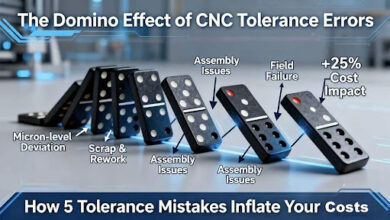5 Research-Driven Strategies to Reduce Your CNC Machining Costs by Up to 40%

Introduction
In today’s competitive global market, manufacturers across sectors—from aerospace to medical devices—consistently face a core challenge: how to effectively control the cost of precision part production while upholding the highest quality standards and accelerating innovation. Traditional cost-cutting methods often focus on the obvious factors like material selection and volume pricing, which can come at the expense of long-term performance and value. True optimization stems from a deeper, more strategic approach—one that integrates engineering design, cutting-edge research, and efficient manufacturing practices.
How Can Strategic Tolerance Design Lead to Up to 40% Cost Savings?
Precision is the cornerstone of CNC machining, but not all dimensional features are equally critical to a part’s function. Blindly applying the tightest tolerances is one of the most common drivers of cost escalation.
Understanding the Exponential Cost-Tolerance Relationship
Tightening tolerance requirements increases manufacturing costs exponentially. It demands more precise machinery, slower feed rates, more frequent tool changes, longer inspection times, and leads to higher scrap rates. According to research on measurement science by the National Institute of Standards and Technology (NIST), the cost of maintaining ultra-tight tolerances far exceeds the material value of the part itself.
Implementing a “Critical Function Analysis”
The solution is to conduct a systematic Critical Function Analysis. This process involves collaborating with manufacturing engineers to identify which features truly impact assembly, function, or safety, and which are merely “nice-to-have.” By consciously relaxing tolerances on non-critical features, resources and budget can be focused where they matter most.
Partner Expertise is Key
Executing this strategy requires a manufacturing partner with a robust quality system, such as those certified to ISO 9001:2015 and IATF 16949. Executing this strategy requires a manufacturing partner with a robust quality system, such as those certified to ISO 9001:2015 and IATF 16949. Their expertise ensures tolerance relaxation is scientific and controlled, safeguarding quality while driving cost efficiency. This kind of data-driven engineering consultation is crucial for translating production experience into concrete, cost-saving optimization advice without compromising quality.
Can Digital Prototyping Be the Key to Reducing Late-Stage Change Costs?
Figure 2: Digital prototyping and a seamless transition to production help identify design flaws early, avoiding costly late-stage changes.
Validating a design before committing to full-scale production is the most effective defense against costly errors. Digital prototyping and rapid manufacturing technologies play an indispensable role at this stage.
-
Early Validation
Using 3D printing or rapid CNC machining to produce functional prototypes allows for the discovery of design flaws, assembly interferences, or performance shortcomings at the lowest possible cost phase. Modifying a CAD file during prototyping is exponentially cheaper than altering a production injection mold.
-
Accelerated Iteration
Rapid prototyping cycles allow design teams to iterate multiple times, optimizing the design for a more reliable and manufacturable outcome. This drastically reduces the risk of failures and delays during mass production.
-
Seamless Transition to Production
Choosing a manufacturer that offers end-to-end services (from rapid prototyping to mass production) ensures seamless design data transfer and direct application of prototyping learnings. This integrated approach, as offered by full-service providers, eliminates data and communication barriers, ensuring knowledge transfer and process continuity.
Do Sustainable Manufacturing Practices Hold Untapped Efficiency and Cost Benefits?
Sustainability in manufacturing is often viewed merely as a compliance cost. However, modern sustainable manufacturing practices are directly linked to operational excellence and cost efficiency.
-
Material & Energy Efficiency
Optimizing tool paths to reduce machining time, selecting recyclable materials, and implementing nesting software to minimize waste all directly lower material and energy consumption, thus reducing costs. For instance, compaines implementing lean energy initiatives driven by an ISO 14001 Environmental Management System have reported reducing their annual operational carbon footprint and associated costs by around 5%.
-
Process Optimization
Adopting lean manufacturing principles to reduce unnecessary motion, waiting, and over-processing not only shortens lead times but also lowers operational overhead.
-
Market Access
A commitment to sustainability is increasingly a key factor in winning contracts from clients who value corporate social responsibility, including many large corporations and institutions.
Sustainability has become a significant market access criterion and brand asset. It helps companies meet major client requirements, enhances brand image, and can command product premiums.
Beyond Price, What Key Factors Should You Evaluate in a Manufacturing Partner?
The lowest quote does not always translate to the lowest total cost of ownership. A truly valuable manufacturing partner offers a suite of capabilities that ensure the long-term success of a project.
-
Comprehensive Technical Capabilities
A supplier that offers a range of services like CNC machining, sheet metal fabrication, injection molding, and surface finishing can recommend the most appropriate and economical technology for a project’s specific needs.
-
Industry-Specific Expertise & Certifications
It is crucial to seek partners with relevant industry certifications. For instance, ISO 13485 is critical for medical devices, while AS9100Dis the gold standard in aerospace. These certifications are a proxy for a rigorous quality culture.
-
Engineering Support & Collaboration
A supplier that provides expert Design for Manufacturability (DFM) feedback early in the project can optimize the design at the source, avoiding cost traps and saving significant resources. As detailed in the technical blog “Climb vs. Conventional Milling: A Precision Puzzle That Many Machinists Misunderstand“, early process choices have a profound impact.
Early engineering collaboration offers the highest value return. Involving manufacturing experts at the design stage optimizes for manufacturability at the source, preventing costly late-stage modifications. This deep technical exchange impacts the total product life cycle cost, offering returns far exceeding mere price differences.
How Do Advanced Technologies Like 5-Axis Machining Add Value Beyond Cost?
While advanced technologies may have a higher upfront cost, the value they deliver in machining complex parts can far outweigh the initial investment.
-
Reduced Setup Times
Technologies like simultaneous 5-axis machining allow for the completion of complex geometries in a single setup. This eliminates error accumulation from multiple re-fixturing, significantly reduces total production time, and enhances overall accuracy. This capability is invaluable for research project components requiring deep cavities, steep undercuts, or complex contours.
-
Design Innovation
These advanced technologies provide engineers and researchers with greater design freedom, allowing them to realize innovative geometries that are impossible or prohibitively expensive with traditional methods.
-
Consistency
By machining a part in one fixture, the geometric positional tolerances of features are better maintained, leading to superior performance and reliability of the final assembly. This is critical for high-demand applications.
Superior consistency significantly reduces quality risks and assembly challenges. Single-setup machining ensures precise geometric relationships between features, greatly improving part interchangeability and assembly efficiency. This provides a solid foundation for product reliability and successful high-volume production.
How Can Collaborative Integration of These Strategies Achieve Maximum Impact?

To realize the full potential of cost optimization, it is key to view these strategies as an interconnected system, not isolated tactics. This means establishing a deep, collaborative partnership with a manufacturing partner from the very concept stage of a project.
| Collaboration Phase | Core Action | Expected Benefit |
|---|---|---|
| Concept Design | Early DFM consultation with supplier engineers | Avoid fundamental design flaws, lock in majority of costs |
| Detailed Design | Joint Critical Function Analysis & tolerance optimization | Achieve significant cost savings while ensuring performance |
| Prototype Validation | Form, fit, and function testing using rapid prototyping | Reduce financial and technical risks in mass production phase |
| Production & Quality | Leverage supplier’s comprehensive quality assurance(e.g., CMM inspection) | Ensure parts consistently meet specifications, avoid downstream costs |
| Continuous Improvement | Feedback production data for future design iterations | Build a lasting competitive advantage and cost-effectiveness |
Conclusion
By adopting the research-based strategies outlined in this article—from strategic tolerance design and digital prototyping to selecting a partner with the right technological expertise and sustainable practices—manufacturers and researchers can significantly enhance the efficiency and cost-effectiveness of their projects. True cost optimization is not about finding the lowest price, but about forging a collaborative partnership that leverages deep engineering knowledge from the very beginning.
This article was contributed by John Zhang, a Senior Manufacturing Engineer at LS Manufacturing, an enterprise committed to delivering operational excellence and measurable cost savings. With over 15 years of experience, he helps engineers and procurement managers tackle complex production challenges. Ready to optimize your next design? Explore more technical insights, please visit their blog.
FAQs
Q: What is the single biggest cost driver in CNC machining?
A: Beyond material and machine time, part geometry complexity, tolerance requirements, surface finish specifications, and order quantity are primary factors.
Q: Is CNC machining suitable for low-volume production?
A: Yes, it is ideal. CNC machining requires no tooling, making it highly flexible. For very high volumes, injection molding may be more cost-effective.
Q: What is the best way to ensure that CNC machined parts meet quality standards and industry regulations?
A: Choosing a supplier with a robust quality control system is essential, including First Article Inspection, in-process checks, and final inspection.
Q: Which is less expensive to machine, aluminum or steel?
A: Generally, aluminum is easier to machine, resulting in less tool wear and faster cycle times, making it less expensive. The final choice depends on application requirements.
Q: How can we ensure a smooth transition from prototype to mass production?
A: Selecting a manufacturer that offers full-service capabilities is key. This ensures design data consistency and allows learning from the prototyping phase to directly inform mass production.



